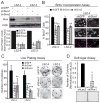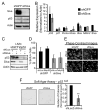The p53 Target Gene SIVA Enables Non-Small Cell Lung Cancer Development
- PMID: 25813352
- PMCID: PMC4456277
- DOI: 10.1158/2159-8290.CD-14-0921
The p53 Target Gene SIVA Enables Non-Small Cell Lung Cancer Development
Abstract
Although p53 transcriptional activation potential is critical for its ability to suppress cancer, the specific target genes involved in tumor suppression remain unclear. SIVA is a p53 target gene essential for p53-dependent apoptosis, although it can also promote proliferation through inhibition of p53 in some settings. Thus, the role of SIVA in tumorigenesis remains unclear. Here, we seek to define the contribution of SIVA to tumorigenesis by generating Siva conditional knockout mice. Surprisingly, we find that SIVA loss inhibits non-small cell lung cancer (NSCLC) development, suggesting that SIVA facilitates tumorigenesis. Similarly, SIVA knockdown in mouse and human NSCLC cell lines decreases proliferation and transformation. Consistent with this protumorigenic role for SIVA, high-level SIVA expression correlates with reduced NSCLC patient survival. SIVA acts independently of p53 and, instead, stimulates mTOR signaling and metabolism in NSCLC cells. Thus, SIVA enables tumorigenesis in a p53-independent manner, revealing a potential new cancer therapy target.
Significance: These findings collectively reveal a novel role for the p53 target gene SIVA both in regulating metabolism and in enabling tumorigenesis, independently of p53. Importantly, these studies further identify SIVA as a new prognostic marker and as a potential target for NSCLC cancer therapy.
©2015 American Association for Cancer Research.
Conflict of interest statement
Figures







Comment in
-
Two Faces of SIVA.Cancer Discov. 2015 Jun;5(6):581-3. doi: 10.1158/2159-8290.CD-15-0484. Cancer Discov. 2015. PMID: 26037915 Free PMC article.
References
-
- Vousden KH, Prives C. Blinded By The Light: The Growing Complexity of p53. Cell. 2009;137(3):413–31. - PubMed
Publication types
MeSH terms
Substances
Grants and funding
LinkOut - more resources
Full Text Sources
Medical
Molecular Biology Databases
Research Materials
Miscellaneous

